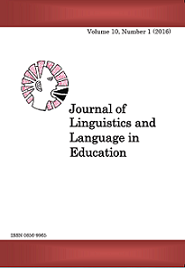Effects of Relativization on the Morpho-syntactic Structure of the Runyambo Verb
Abstract
This article intends to move a step beyond brief description of subject
and object relativization provided in the grammar of Runyambo (cf.
Rugemalira, 2005: 101-103). It aims at describing the formation of
relative clauses in Runyambo and it specifically analyses the effects of
relativization of different grammatical functions (GFs) of the morphosyntactic
structure of the Runyambo verb. Descriptive research design
was used in conjunction with a qualitative approach in data collection
and analysis of findings. Ten (10) respondents were purposively selected
to inform the study. The findings included (i) the relativization of the
subject NP nominalises the verb; (ii) the relativization process alters the
position of tense markers within the relative verbs for the present
continuous, and the immediate future tenses; and (iii) the relativization
of different GFs changes the present continuous and immediate future
tense marker ' ni ' ' is/are ' , and the remote past tense marker ' ka ' (P3) into
' ri-ku ' ' is/are ' and á (P1) €¦Ãre (P2), respectively.
References
Alphonce, C. (2018). A syntactic Analysis of Relative Clauses in the
Southern Cushitic Language, Iraq. Journal of Education
Humanities and Sciences, 7(2): 42 €“61.
Andrews, A. D. (2007). Complex Constructions. In T. Shopen (ed).
Language Typology and Syntactic Description (2nd Edition).
Cambridge: Cambridge University Press: 206 €“236. Bryman, A. (2011).
Triangulation: Encyclopaedia of Social Science Research
Methods. LOCATION? SAGE Publications.
Cheng, L. & Kula, N. (2006). Syntactic and Phonological Phrasing in
Bemba Relative Clauses. ZAS Papers in Linguistics, (43): 31 €“
Comrie, B. & Kuteva, T. (2013). Relativization on Subjects. In M. S.
Dryer & M. Haspelmath (eds.). The World Atlas of Language Structures
Online. Leipzig: Max Planck Institute for Evolutionary
Anthropology.
Comrie, B. (1989). Language Universals and Linguistic Typology.
Oxford: Blackwell Publishers.
Creswell, J. W. (2013). Qualitative Inquiry and Research Design:
Choosing among Five Approaches (3rd Edition). Thousand Oaks,
CA: Sage.
Demuth, K. & Harford, C. (1999). Verb Raising and Subject Inversion in
Comparative Bantu. Journal of African Languages and
Linguistics, 20 (1): 41 €“61.
Guthrie, M. (1948). The Classification of the Bantu Languages. London:
Oxford University Press.
Kaoneka, S. (2018). The Morphosyntax of Relative Clauses in
Shambala. Unpublished PhD Thesis, University of Dar es
Salaam.
Keenan, E. L. & Comrie, B. (1977). Noun Phrase Accessibility Hierarchy
and Universal Grammar. Linguistic Inquiry, 8(1): 63 €“99.
Kimenyi, A. (1978). A Relational Grammar of Kinyarwanda. California:
University of California Press.
Kombe, L. E. (2010). Relative Clause Formation in Kivunjo.
Unpublished M.A. Dissertation, University of Dar es Salaam.
Kuteva, T & Comrie, B. (2005). The Typology of Relative Clause
Formation in African Languages. In E. F. K. Voeltz (ed.).
Studies in African Linguistic Typology. Amsterdam &
Philadelphia: Benjamins: 209 €“228.
Mkude, D. J. (2005). The Passive Construction in Swahili. Research
Institute for Languages and Cultures of Asia and Africa
(ILCAA), Tokyo University of Foreign Studies.Mtenje, A. (2011). On
Relative Clauses and Prosodic Phrasing in
Ciwandya. ZAS Papers in Linguistics, 55: 121 €“139. Ngonyani, D. (2001).
Evidence for Head Rising in Kiswahili Relative
| Effects of Relativization
Clauses. Studies in African Linguistics, 30(1): 59 €“73.
Payne, T. E. (1997). Describing Morphosyntax: A Guide to Field
Linguists. Cambridge: Cambridge University Press.
Riedel, K. (2010). Relative Clauses in Haya. ZAS Papers in Linguistics,
: 211 €“225.
Rugemalira, J. M. (2005). A Grammar of Runyambo. Dar es Salaam:
Languages of TanzaniaProject, University of Dar es Salaam.
Simango, S. R. (2006). Verb Agreement and the Syntax of ciNsenga
Relative Clauses. Southern African Linguistics and Applied
Language Studies, 24(3): 277 €“290.
Vries, M. de (2002). The Syntax of Relativization. Unpublished PhD
Dissertation, University of Amsterdam.
Walusimbi, L. (1996). Relative Clauses in Luganda. Köln : Rüdiger
Köppe Verlag.
Zeller, J. (2004). Relative Clause Formation in the Bantu Languages of
the South Africa. Southern African Linguistics and Applied
Language Studies, 22(1 €“2): 75 €“93
Downloads
Published
Issue
Section
License
Copyright © by Department of Foreign Languages and Linguistics, University of Dar es Salaam
All rights reserved. No part of this publication may be reproduced or transmitted in any form or by any means, electronic or mechanical, including photocopying, recording, or any information storage or retrieval system, without permission in writing from the publisher, except for short extracts in fair dealing, for research or private study, critical scholarly review or discourse with an acknowledgement.



